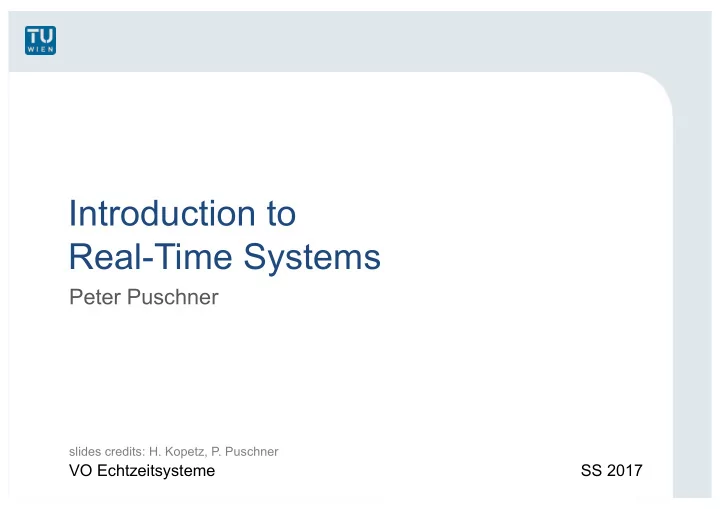

Introduction to Real-Time Systems Peter Puschner slides credits: H. Kopetz, P. Puschner VO Echtzeitsysteme SS 2017
What is a Real-Time System? • Definition 1: RT-systems are systems in which the correctness of the system behavior depends • on the logical results of the computations, and • on the physical time when these results are produced • Definition 2: RT-systems are systems that have to be designed according to the dynamics of a physical process 2
What is a Real-Time System? (2) 3
What is a Real-Time System? (3) • Often part of an embedded or cyber-physical system • Computer system performs a specific task (not general purpose) • Tight interaction with physical environment (sensors, actuators) • Dependability • Resource efficiency (cost are critical) • Increasing importance of security 4
Example Real-Time Application Many real-time systems are control systems Example: simple one-sensor, one-actuator control system reference A/D input Computation D/A (control law) A/D Plant (controlled sensor actuator system) 5
Example Real-Time Application – Pseudo Code Initialize periodic interrupt timer with period T Interrupt service routine: do analog-to-digital conversion for input value compute control output from reference and input value do digital-to-analog conversion for control output • T … sampling period • T is application dependent, chosen by system designer • Range of T: milliseconds to seconds 6
Misconceptions about Real-Time Systems (Stankovic, IEEE Computer, 1988) • “Real-time computing is equivalent to fast computing.” • “real-time” sounds cool/good – term often used to advertise products • “Real-time programming is assembly coding,...” • Proper models, design and development process 7
Challenges – What is Difficult about RTS? 1. Reactive behavior • Continuous operation • Pace is controlled by environment 2. Concurrency • Devices operate in parallel in the real-world • Conflicts with sequential execution on controller • Hard to maintain deterministic, reproducible behavior 3. Guaranteed response times • Predictability is essential – still efficiency is important • Worst case must be predictable • Response times on system level 8
What is Difficult about RTS? 4. Interaction with special purpose hardware • Devices must be programmed in a reliable and abstract way • Interfaces, device drivers are often a large development-time sink 5. Maintenance usually difficult • Hardly maintenance loop • Instead: “First time right” 6. Harsh environment • Temperature, EMI, radiation, etc. 7. Constrained resources • Processing power, memory, power, etc. 9
What is Difficult about RTS? 8. Often cross development • Target platform ≠ development platform 9. Size and complexity • Few lines of assembler code … x100 million lines of code (car, plane) 10. Reliability and safety requirements • Embedded systems control the environment in which they operate • Control failures can result in - enormous damage to environment - substantial financial loss - the loss of human life 10
Deadline response time Environment deadline RTCS 11
Deadline • The time at which a real-time systems has to produce a specific result is called a deadline. • Deadlines are dictated by the environment. • What happens if an RTS misses a deadline? 12
Classification of Real-Time Systems • Soft RTS • The result has utility after the deadline. • Respective deadline is called a soft deadline. • Firm RTS • The result has zero utility after the deadline. • Hard RTS • Missing a deadline may be catastrophic. • Critical deadline is called hard deadline. • HRTS has at least one hard deadline • Hard and Soft RTS design are fundamentally different! 13
Fail-Safe versus Fail-Operational Applications Fail-safe system: has a safe state in the environment that can be reached in case of a system failure (e.g., train signaling). • Fail safeness is an application property. • High error detection coverage is critical . • Use of watchdog, heart-beat signal. Fail-operational system: no safe state can be reached in case of a system failure (e.g., a flight control system of airplane). • Computer system has to provide a minimum level of service, even after the occurrence of a fault. • Active redundancy 14
Guaranteed Timeliness versus Best Effort Guaranteed timeliness of a system implementation • Load and fault hypothesis is available • Temporal correctness can be shown by analytical arguments • Assumption coverage is critical Best effort system implementation • Analytical argument for temporal correctness cannot be made. • The temporal verification relies on probabilistic arguments, even within the specified load- and fault hypothesis. Hard real-time systems must be based on guaranteed timeliness. 15
Resource Adequacy In order to provide timing guarantees a system has to • provide sufficient computational resources to handle • the specified peak load and • fault scenarios. In the past, resource adequacy has been considered too expensive . Today, decreasing hardware cost make the implementation of resource adequate designs economically viable. For hard real-time applications, there is no alternative to resource adequate designs . 16
Predictability in Rare-Event Situations Rare Event • important event that • occurs very infrequently during the lifetime of a system (e.g., the rupture of a pipe in a nuclear reactor). • can give rise to many correlated service requests (e.g., an alarm shower). In a number of applications • the utility of a system depends on the predictable performance in rare event scenarios (e.g., flight control system). • In many cases, workload testing will not cover the rare event scenario. 17
Hard versus Soft RTS Characteristic Hard Real Time Soft Real Time Deadlines hard soft Pacing environment computer Peak-Load Perform. predictable degraded Error Detection system user Safety critical non-critical Redundancy active standby Time Granularity millisecond second Data Files small/medium large Data Integrity short term long term 18
Points to Remember • RT is not about performance (fast is not real-time) • Hard RT systems are safety critical • Predictability is important • RT does not imply ad-hoc, low-level design • RT design has to be systematic • Timing is central • Architecture (hardware and software) • Design, implementation and verification process 19
Recommend
More recommend